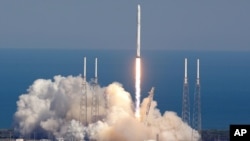A SpaceX Falcon 9 rocket blasted off from Florida on a cargo run for the International Space Station on Friday and its reusable main-stage booster landed itself on an ocean platform in a dramatic spaceflight first.
The liftoff at 4:43 p.m. EDT (2043 GMT) from Cape Canaveral marked the resumption of resupply flights by privately-owned Space Exploration Technologies for NASA following a launch accident in June 2015 that destroyed a different cargo payload for the space station.
About two-and-a-half minutes after Friday's launch, the main part of the 23-story tall, two-stage SpaceX rocket separated, turned around and headed toward a landing platform floating in the Atlantic about 185 miles (300 km) northeast of Cape Canaveral.
A live video feed broadcast on NASA television showed the rocket booster, its four landing legs extended, descending over the ocean before settling itself upright on the platform, roughly eight minutes after launch.
"We have a Falcon 9 onboard," a crewman on a nearby recovery vessel radioed to SpaceX mission control.
Four previous at-sea landing attempts had failed. But a Falcon 9 main-stage rocket achieved a successful ground-based touchdown in December, the first ever during an actual commercial space mission.
Friday's feat marked yet another major milestone in the quest by high-tech entrepreneur Elon Musk, founder and chief executive of the private launch service, to develop a cheap, reusable launch vehicle.
"Looking forward to delivering the goods for you," Musk wrote in a Tweet to the U.S. space agency after the launch.
The rocket's cargo ship, dubbed Dragon, was due to arrive on Sunday at the International Space Station, the $100 billion laboratory flying about 250 miles (400 km) above Earth.
The delivery vehicle was packed with about 7,000 pounds (3,175 kg) of food, supplies and science experiments, including a prototype inflatable habitat, bound for the orbital outpost.
About a week after Dragon's arrival, ground controllers will use a robot arm on the space station to pull the 3,100-pound (1,400 kg) Bigelow Expandable Activity Module, or BEAM, from the capsule's trunk and attach it to a berthing port.
Built by Nevada-based Bigelow Aerospace, the lightweight fabric habitat will be tested to see how it compares with more traditional orbiting enclosures made from metal.
Roughly a month after its arrival, astronauts aboard the space station will inflate BEAM with pressurized air, increasing its volume to about the size of a small bedroom.
Bigelow Aerospace, owned and operated by real estate billionaire Robert Bigelow, plans to follow BEAM with modules 20 times larger to serve as free-flying orbital outposts leased to companies and research groups.
NASA is interested in expandable habitats to serve as crew living quarters during three-year trips to and from Mars.
BEAM's test run is intended to determine how well it withstands the temperature swings and high-radiation environment of space. The module, made of layers of fabric and covered in a flexible, Kevlar-like material, also will be outfitted with sensors to monitor orbital debris and micrometeoroid impacts.









